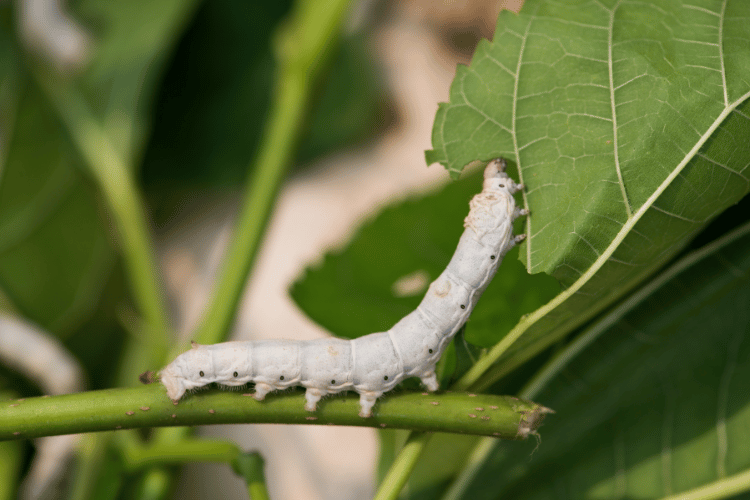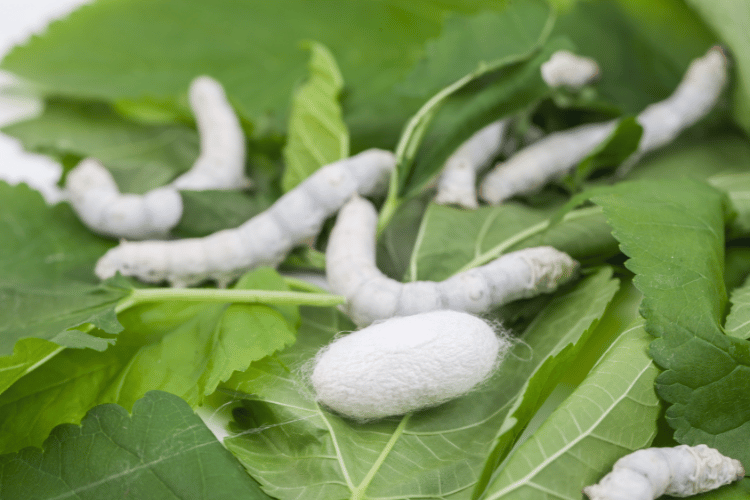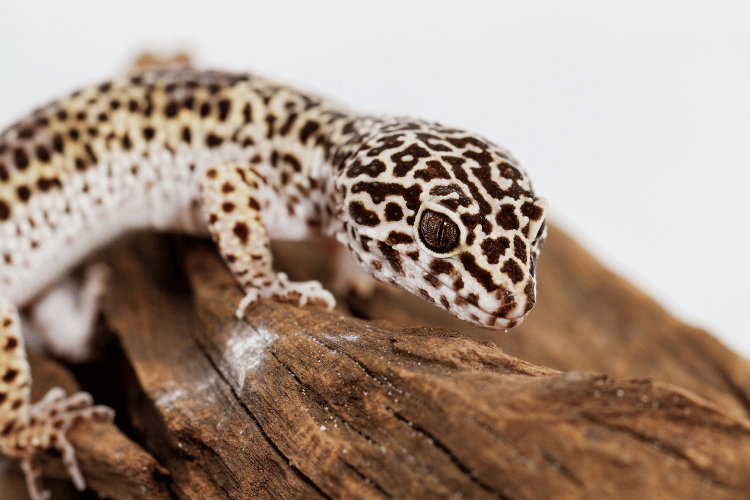Leopard geckos thrive on a diverse menu, often comprising crickets, mealworms, and other insects. While the diversity makes sure they’re getting the nutrition they need, it also raises some questions about how far the diet can go. For example, can leopard geckos eat silkworms?
In this article, we’ll explore the nutritional aspects of silkworms, discuss their compatibility with leopard gecko diets, and offer practical insights into incorporating these silk-spinning wonders into your gecko’s daily diet.
Nutritional Value of Silkworms
Silkworms, often associated with silk production, surprisingly pack a nutritional punch that could benefit your gecko. These soft-bodied larvae boast a commendable protein content, crucial for muscle development and overall health.
Additionally, their fat content is moderate, offering a balanced nutritional profile.
When compared to other common feeder insects, silkworms stand out for their rich vitamin and mineral content, so they’re generally a good source of nutrition for animals that prey on them.

Leopard Gecko Dietary Requirements
To create a diet that ensures optimal health for leopard geckos, you must have a comprehensive understanding of their dietary requirements. These endearing reptiles, known for their distinctive appearance and docile nature, thrive on a diverse menu that mirrors their natural feeding habits.
Leopard geckos are insectivores by nature, meaning their primary source of nutrition comes from insects and invertebrates.
The foundation of their diet typically includes crickets and mealworms, which serve as staple food items. These insects provide the necessary protein, essential for muscle development, and form the cornerstone of a balanced diet.
In addition to protein, leopard geckos require a variety of vitamins and minerals to maintain overall well-being. A well-rounded diet contributes to proper bone development, reproductive health, and a robust immune system.
Calcium and vitamin D3 are particularly crucial for preventing metabolic bone disease, a common condition in captive reptiles.
To meet these dietary needs, leopard gecko owners often incorporate supplements, such as calcium powder, into their pet’s diet. Proper supplementation ensures that your gecko receives the necessary nutrients, especially when feeder insects alone may not provide an optimal balance.
Can Leopard Geckos Eat Silkworms?
While leopard geckos are known for their resilient appetites and adaptability, the question remains: Can these charming reptiles feast on silkworms?
Silkworms present a promising nutritional profile, rich in protein, moderate in fat, and laden with essential vitamins and minerals. So, the answer is a resounding yes.
Silkworms can be a valuable component of a leopard gecko’s diet, contributing to the essential nutrients needed for growth, vitality, and overall health. Their soft exoskeleton makes them easy to consume, even for younger geckos or those with specific dietary preferences.
However, as with any dietary change, moderation is key. Silkworms should complement, not replace, the existing feeder insects in your gecko’s diet. This ensures a well-balanced intake of proteins, fats, and other essential nutrients.
While staples like crickets and mealworms remain crucial, incorporating silkworms adds a novel texture and flavor to your gecko’s diet. This variety not only stimulates their interest in mealtime but also broadens the spectrum of nutrients they receive.
How to Feed Silkworms to Leopard Geckos
If you want to feed silkworms to your gecko but don’t know where to start, here are a few steps to follow:
1. Consider Size

When introducing silkworms to your leopard gecko’s diet, size matters. Opt for silkworms that are appropriately sized for your gecko’s age and size.
Younger geckos may require smaller silkworms, while adults can handle larger ones. Ensuring the size is proportionate prevents potential choking hazards and makes for a safer eating experience.
2. Maintain Feeding Frequency
Balancing the introduction of silkworms into your gecko’s diet involves considering the feeding frequency.
Silkworms can be offered as a supplement rather than a daily staple. Alternating them with other feeder insects maintains variety in the diet and prevents overreliance on a single food source.
3. Ensure Proper Gut-Loading and Supplementation
For silkworms to be a nutritional boon for your leopard gecko, you have to pay close attention to gut-loading and supplementation.
Gut-loading involves feeding the silkworms a nutrient-rich diet before offering them to your gecko. This improves the silkworms’ nutritional content, ensuring your gecko receives optimal benefits.
Additionally, dusting or gut-loading the silkworms with calcium and vitamin supplements helps maintain a balanced diet.
4. Monitor Leopard Gecko’s Response to Silkworms
As you integrate silkworms into your gecko’s diet, closely observe their response. Some geckos may readily embrace the new addition, while others might exhibit preferences for certain insects.
Monitoring their behavior, appetite, and overall health provides insights into how well silkworms complement their diet. Adjust the frequency or size based on your gecko’s individual needs and preferences.
Potential Concerns and Risks

As with any dietary addition, introducing silkworms to your leopard gecko’s menu requires careful consideration of potential concerns and risks.
While these soft-bodied larvae offer nutritional benefits, it’s essential to be aware of certain aspects to ensure the well-being of your scaly companion.
Allergies or Adverse Reactions
Leopard geckos, like any living beings, may exhibit allergies or adverse reactions to new foods.
When introducing silkworms, observe your gecko for any signs of distress, such as lethargy, changes in behavior, or digestive issues. If adverse reactions occur, consult with a vet to determine the best course of action.
Parasite Risk
Although silkworms are generally considered a low-risk feeder, it’s crucial to source them from reputable suppliers.
Poor hygiene or contaminated food sources can pose a risk of parasites. Ensure that the silkworms are healthy and come from a reliable source to minimize the likelihood of introducing harmful parasites to your gecko.
Balancing Silkworms with Other Feeder Insects
While silkworms offer valuable nutrients, it’s important not to exclusively rely on them. Maintaining a varied diet is key to meeting all of your leopard gecko’s nutritional needs.
Silkworms should complement other feeder insects like crickets, mealworms, and roaches to ensure a balanced intake of proteins, fats, and essential vitamins.
Conclusion
In conclusion, silkworms offer a welcomed variety to the customary insect fare of geckos’ diet. However, you’ll want to be careful about size, frequency, and supplementation.
If you manage to incorporate them into your gecko’s diet correctly, they’ll make a fruitful addition. Their high protein content is good for your pet gecko.
- Can Leopard Geckos Eat Silkworms? - March 11, 2024
- Do Leopard Geckos Climb? - March 4, 2024
- Do Leopard Geckos Bask? The Answer Will Surprise You - February 21, 2024
